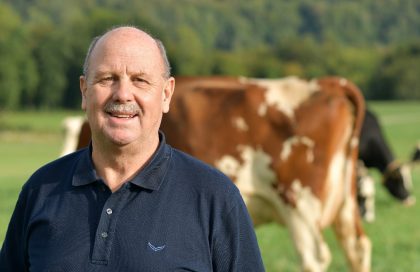The three “Ms” of green and healthy lactation research: Metabolism, Mastitis and Milking efficiency
The Journal of Dairy Research Editor’s Choice Article is “Influence of nutrient availability on in vitro growth of major bovine mastitis pathogens” by by Remo Stürmlin et al.
Switzerland has a well deserved eco-friendly reputation, and several times in the last few years has topped the global Environmental Performance Index country rankings. Swiss agriculture certainly plays its part in this success story, the mountainous pastures being home to many small dairy farms which are regarded, socially and politically, as a vital part of normal day-to-day life.

We spoke to Rupert Bruckmaier, Head of the Veterinary Physiology Group in the Vetsuisse Faculty of the University of Bern, about the research priorities that he believes are important in supporting Swiss dairying. Rupert has been at the forefront of dairy research for several decades, and his research group has been working on the metabolism of dairy cows in particular during periods of metabolic imbalance and lack of energy. Metabolic efficiency inevitably confers environmental benefit, as does the topic of this issue’s featured article, animal health. Not surprisingly then, another significant field of research for Rupert and his colleagues is the function of the mammary gland and in particular the immune response during mastitis.
A current project supported by the Swiss National Science Foundation combines these two fields of metabolism and health. It has been demonstrated that glucose is the prioritized energy source for the immune response, but also beta-hydroxybutyrate (BHB) is used as an energy source during mastitis, probably for heat production during fever. At the same time, BHB inhibits the immune reaction. Besides their impact on the availability of energy and nutrients for the immune system, metabolic imbalances also cause changes of milk composition such as high concentrations of urea or fat, and the concentration of lactose and protein can be reduced during energy deficiency. This led the Swiss researchers to ask the question, might increased mastitis susceptibility in dairy cows be due to metabolic imbalances and changed milk composition?
Their article investigates the impact of changed milk composition on the growth of major mastitis pathogens in vitro, that is to say, without any compounding contribution from the immune response of the cow. The study showed that only dramatic changes of milk composition, mainly involving vitamins and minerals, showed an impact on bacterial growth. Such differences in milk composition can only be created by manipulation of milk or culture medium in vitro, and would never occur due to nutrient imbalances in vivo.
This novel study is proof that milk, even if subjected to changes within a physiological range, is always an abundant source of nutrients for the growth of all relevant mastitis pathogens. Differences in the susceptibility and severity of different types of mastitis during the course of lactation depend primarily on the capacity of the immune system, which is subject to change as a consequence of metabolic imbalance. Potential alterations in milk composition are not relevant for bacterial growth. Turning to the third of the “three Ms”, it is important to recognize the importance of milking efficiency and the milk ejection reflex for normal milk production, and during mastitis the reflex becomes even more important if the pathogen is to be cleared effectively. For almost 40 years, much of Rupert’s research has focused on milk ejection and its interaction with conventional and automatic milking systems including current developments in milking machine settings. So will he be tempted to combine all three themes in future research? Only time will tell!
The paper “Influence of nutrient availability on in vitro growth of major bovine mastitis pathogens” by Remo Stürmlin, Josef J. Gross, Olga Wellnitz, Lea A. Wagner, Camille Monney, Anna Oevermann and Rupert M. Bruckmaier, published in The Journal of Dairy Research, is available free for a month.






